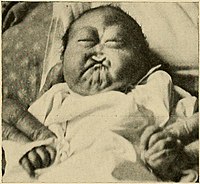
Photo from wikipedia
The purpose of this study was to evaluate the effectiveness of next-generation sequencing (NGS)-based preimplantation genetic testing (PGT) for balanced translocation carriers to identify normal/balanced blastocysts and to measure pregnancy… Click to show full abstract
The purpose of this study was to evaluate the effectiveness of next-generation sequencing (NGS)-based preimplantation genetic testing (PGT) for balanced translocation carriers to identify normal/balanced blastocysts and to measure pregnancy outcomes following euploid embryo transfer. We enrolled 75 couples with a balanced translocation who underwent 83 PGT cycles (58 cycles for carriers with reciprocal translocations and 25 cycles for carriers with Robertsonian translocations) and 388 blastocysts were diagnosed. Moreover, we transferred single euploid blastocysts through frozen embryo transfer and calculated the biochemical pregnancy, clinical pregnancy, miscarriage, and ongoing pregnancy rates per embryo transfer cycle. Despite a mean maternal age of 29.8 years and mean of 4.34 embryos biopsied, there was a 32.8% chance of recording no chromosomally normal/balanced embryos for reciprocal translocation carriers. The proportion of normal/balanced embryos was significantly higher (44.1 vs. 27.8%) in Robertsonian translocation carriers than in reciprocal translocation carriers. Female carriers had a significantly lower (23.3 vs. 42.4%, 34.7 vs. 54.7%, respectively) percentage of normal/balanced embryos than male carriers, regardless of the translocation. After transfering single blastocysts, we obtained a 64.4% clinical pregnancy rate per transfer, and the clinical miscarriage rate was 5.7%. Amniocentesis results showed that all karyotypes of the fetuses were consistent with PGT results. The clinical outcomes are probably not influenced by the type of translocation, maternal age, and blastocyst morphology following the transfer of euploid blastocysts. Therefore, we conclude that NGS-based PGT is an efficient method for analyzing balanced translocation carriers, and aneuploidy screening had good clinical outcomes.
Journal Title: Cytogenetic and Genome Research
Year Published: 2020
Link to full text (if available)
Share on Social Media: Sign Up to like & get
recommendations!